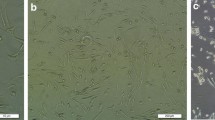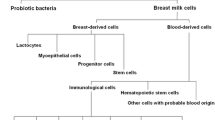Abstract
The immense potency of nutritional components of human breast milk and importance of breastfeeding is known worldwide. Recent researches had identified stem cells as integral component of human breast milk. Nevertheless, there is little proof of evidence on the stem cell constituents of breast milk. It is imperative to explore the cellular constituents of human breast milk, including of stem cells, to open new avenue in child’s development and regeneration. Thus, we aimed at identifying the cellular constituents of human breast milk by phenotypic characterisation of diverse cell surface markers of hematopoietic stem cells (CD 34, CD 133, CD 117), mesenchymal stem cells (CD 90, CD 105, CD 73), myoepithelial cells (CD 29, CD 44), Immune cells (CD 209, CD 86, CD 83, CD 14, CD 13, HLADR, CD 45), as well as cell adhesion molecules (CD 31, CD 54, CD 166, CD 106, CD 49d), and other markers (ABCG2, CD140b) using flowcytometry. We found a lower expression of CD 34 (13.07 ± 2.0 %), CD 90 (7.79 ± 0.8 %) and CD 73 (2.19 ± 0.41 %), indicating scanty hematopoietic and mesenchymal stem cell population in human breast milk. On contrary, myoepithelial progenitors, cell adhesion molecules, immune cells and growth factors were identified as the major constituents of breast milk. Overall, this study illuminates the benefits of breast feeding as breast milk encompasses heterogeneous cellular components that benefits child’s growth, immunity and development. However, further research on these constituents of human breast milk will widen their applicability in treatment of neonatal disorders.




Similar content being viewed by others
References
Boutinaud M, Jammes H (2002) Potential uses of milk epithelial cells: a review. Reprod Nutr Dev 42:133–147
Campagnoli C, Roberts IA, Kumar S, Bennett PR, Bellantuono I, Fisk NM (2001) Identification of mesenchymal stem/progenitor cells in human first-trimester fetal blood, liver, and bone marrow. Blood 98:2396–2402
Cregan MD, Fan Y, Appelbee A, Brown ML, Klopcic B, Koppen J, Mitoulas LR, Piper KM, Choolani MA, Chong YS, Hartmann PE (2007) Identification of nestin-positive putative mammary stem cells in human breastmilk. Cell Tissue Res 329:129–136
De Bari C, Dell’Accio F, Tylzanowski P, Luyten FP (2001) Multipotent mesenchymal stem cells from adult human synovial membrane. Arthritis Rheum 44:1928–1942
De Ugarte DA, Morizono K, Elbarbary A, Alfonso Z, Zuk PA, Zhu M, Dragoo JL, Ashjian P, Thomas B, Benhaim P, Chen I, Fraser J, Hedrick MH (2003) Comparison of Multi-lineage cells from human adipose tissue and bone marrow. Cells Tissues Organs 174:101–109
Dominici M, Le Blanc K, Mueller I, Slaper-Cortenbach I, Marini FC, Krause DS, Deans RJ, Keating A, Prockop DJ, Horwitz EM (2006) POSITION PAPER minimal criteria for defining multipotent mesenchymal stromal cells. The International Society for Cellular Therapy position statement. Cytotherapy 8:315–317
Dontu G, Abdallah WM, Foley JM, Jackson KW, Clarke MF, Kawamura MJ, Wicha MS (2003) In vitro propagation and transcriptional profiling of human mammary stem/progenitor cells. Genes Dev 17:1253–1270
Fan Y, Chong YS, Choolani MA, Cregan MD, Chan JKY (2010) Unravelling the mystery of stem/progenitor cells in human breast milk. PLoS One 5:e14421
Fuchs E, Segre JA (2000) Stem cells: a new lease on life. Cell 100:143–155
Gargett CE, Schwab KE, Zillwood RM, Nguyen HPT, Wu D (2009) Isolation and culture of epithelial progenitors and mesenchymal stem cells from human endometrium. Biol Reprod 80:1136–1145
Gimble J, Guilak F, Bunnell B (2010) Clinical and preclinical translation of cell-based therapies using adipose tissue-derived cells. Stem Cell Res Ther 1:19
Hamosh M (2001) Bioactive factors in human milk. Pediatr Clin North Am 48:69–86
Hanson LA (1999) Human milk and host defence: immediate and long-term effects. Acta Paediatr Suppl 88:42–46
Hanson L, Silfverdal SA, Strömbäck L, Erling V, Zaman S, Olcén P, Telemo E (2001) The immunological role of breast feeding. Pediatr Allergy Immunol 12:15–19
In’t Anker PS, Scherjon SA, Kleijburg-van der Keur C, Noort WA, Claas FH, Willemze R, Fibbe WE, Kanhai HH (2003) Amniotic fluid as a novel source of mesenchymal stem cells for therapeutic transplantation. Blood 102:1548–1549
Jones EA, English A, Henshaw K, Kinsey SE, Markham AF, Emery P, McGonagle D (2004) Enumeration and phenotypic characterisation of synovial fluid multipotential mesenchymal progenitor cells in inflammatory and degenerative arthritis. Arthritis Rheum 50:817–827
Kern S, Eichler H, Stoeve J, Kluter H, Bieback K (2006) Comparative analysis of mesenchymal stem cells from bone marrow, umbilical cord blood, or adipose tissue. Stem Cells 24:1294–1301
Kim J, LeeY Kim H, Hwang KJ, Kwon HC, Kim SK, Cho DJ, Kang SG, You J (2007) Human amniotic fluid-derived stem cells have characteristics of multipotent stem cells. Cell Prolif 40:75–90
Kørbling M, Estrov Z (2003) Adult stem cells for tissue repair—a new therapeutic concept? N Engl J Med 349:570–582
Labbok MH, Clark D, Goldman AS (2004) Breastfeeding: maintaining an irreplaceable immunological resource. Nat Rev Immunol 4:565–572
Musina RA, Belyavski AV, Tarusova OV, Solovyova EV, Sukhikh GT (2008) Endometrial mesenchymal stem cells isolated from the menstrual blood. Bull Exp Biol Med 145:539–543
Pabst HF (1997) Immunomodulation by breast-feeding. Pediatr Infect Dis J 16:991–995
Patki S, Kadam S, Chandra V, Bhonde R (2010) Human breast milk is a rich source of multipotent mesenchymal stem cells. Hum Cell 23:35–40
Sabatini F, Petecchia L, Tavian M, Jodon de Villeroché V, Rossi GA, Brouty-Boyé D (2005) Human bronchial fibroblasts exhibit a mesenchymal stem cell phenotype and multilineage differentiating potentialities. Lab Invest 85:962–971
Salingcarnboriboon R, Yoshitake H, Tsuji K, Obinata M, Amagasa T, Nifuji A, Noda M (2003) Establishment of tendon-derived cell lines exhibiting pluripotent mesenchymal stem cell-like property. Exp Cell Res 287:289–300
Schwab KE, Gargett CE (2007) Co-expression of two perivascular cell markers isolates mesenchymal stemlike cells from human endometrium. Hum Reprod 22:2903–2911
Seo BM, Miura M, Gronthos S, Bartold PM, Batouli S, Brahim J, Young M, Robey PG, Wang CY, Shi S (2004) Investigation of multipotent postnatal stem cells from human periodontal ligament. Lancet 364:149–155
Stingl J, Eaves C, Zandieh I, Emerman JT (2001) Characterisation of bipotent mammary epithelial progenitor cells in normal adult human breast tissue. Breast Cancer Res Treat 67:93–109
Tsai MS, Lee J-L, Chang YJ, Hwang SM (2004) Isolation of human multipotent mesenchymal stem cells from second-trimester amniotic fluid using a novel two-stage culture protocol. Hum Reprod 19:1450–1456
Zuk PA, Zhu M, Ashjian P, De Ugarte DA, Huang JI, Mizuno H, Alfonso ZC, Fraser JK, Benhaim P, Hedrick MH (2002) Human adipose tissue is a source of multipotent stem cells. Mol Biol Cell 13:4279–4295
Author information
Authors and Affiliations
Corresponding author
Rights and permissions
About this article
Cite this article
Indumathi, S., Dhanasekaran, M., Rajkumar, J.S. et al. Exploring the stem cell and non-stem cell constituents of human breast milk. Cytotechnology 65, 385–393 (2013). https://doi.org/10.1007/s10616-012-9492-8
Received:
Accepted:
Published:
Issue Date:
DOI: https://doi.org/10.1007/s10616-012-9492-8




